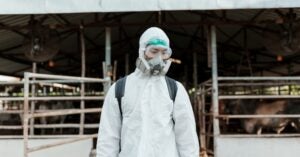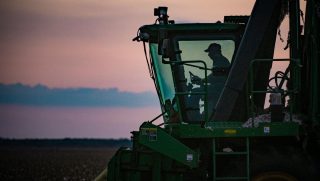The Centers for Disease Control and Prevention are now recommending personal protective equipment for livestock workers amid concerns for H5N1 transmission to humans.
The CDC made the request this week, asking state officials to make PPE available for livestock workers amid the spreading avian influenza. Though the risk remains low for the general public, according to the CDC, workers who are in close proximity to livestock, such as dairy farmers, poultry farmers, and slaughterhouses, may have a higher risk of infection.
“CDC asked that jurisdictions make PPE available to workers on dairy farms, poultry farms, and in slaughterhouses. Specifically, the CDC asked state health departments to work with their state agriculture department counterparts and partners in communities, such as farmworker organizations, that can help coordinate and facilitate PPE distributions,” said a notice from the CDC.

The extra precautions come despite only two reported cases in people that occurred in April: One dairy workers who was exposed to cattle in Texas, and another in Colorado who was involved in culling poultry that were believed to have been infected with H5N1.
The Texas case “reported eye redness (consistent with conjunctivitis), as their only symptom”. Meanwhile, the Colorado case reported “fatigue for a few days as their only symptom and has since recovered,” according to the CDC.
U.S. Food and Drug Administration Commissioner Dr. Robert Califf further addressed growing bird flu concerns at a congressional hearing Wednesday. He told senators on a panel that despite a low probability of the strain of avian influenza that is affecting dairy cattle jumping to humans, preparation needed to be taking place.

Califf told senators that the virus (like all viruses) continues to mutate but that the “real worry is that it will jump to the human lungs where, when that has happened in other parts of the world for brief outbreaks, the mortality rate has been 25 percent.”
The FDA is currently working on medical countermeasures.
“So we got to have testing. Gotta have antivirals, and we need to have a vaccine ready to go. So we’ve been busy, getting prepared for if the virus does mutate in a way that jumps into humans on a larger level,” Califf said.
Currently, there are 36 dairy herds across nine states affected by H5N1: Colorado, Idaho, Kansas, Michigan, New Mexico, North Carolina, Ohio, South Dakota, and Texas.
Califf stated that the FDA holds confidence in the scalability of vaccine production if required, and assures that the current mRNA platforms are adaptable to address emerging strains.
“We’re in an enviable position compared to any time in the history of the world,” Califf said. “Viruses are relatively simple, so coming up with a matching vaccine is entirely possible in a short period of time.”

